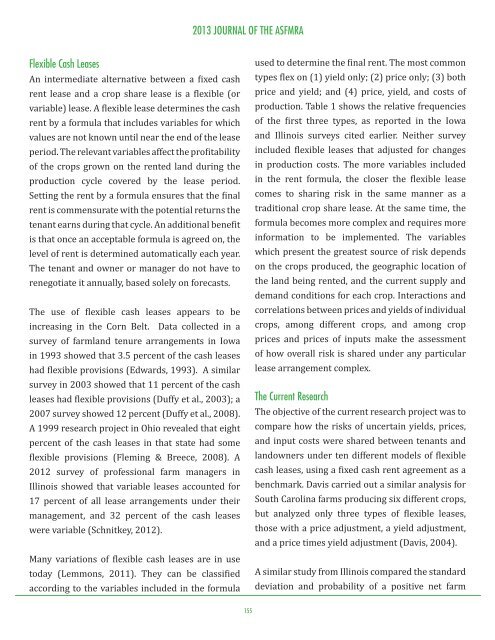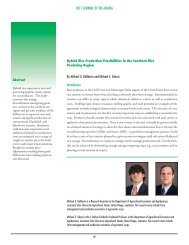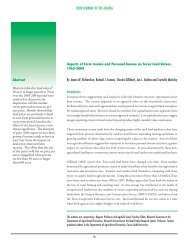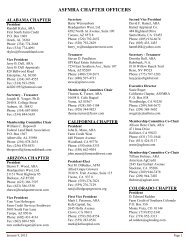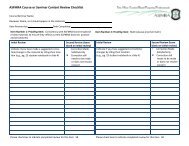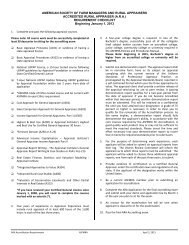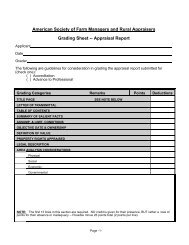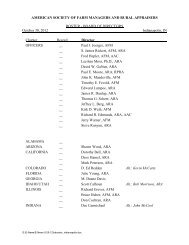Sharing Financial Risk through Flexible Farm Lease Agreements
Sharing Financial Risk through Flexible Farm Lease Agreements
Sharing Financial Risk through Flexible Farm Lease Agreements
Create successful ePaper yourself
Turn your PDF publications into a flip-book with our unique Google optimized e-Paper software.
2013 JOURNAL OF THE ASFMRA<br />
<strong>Flexible</strong> Cash <strong>Lease</strong>s<br />
An intermediate alternative between a fixed cash<br />
rent lease and a crop share lease is a flexible (or<br />
variable) lease. A flexible lease determines the cash<br />
rent by a formula that includes variables for which<br />
values are not known until near the end of the lease<br />
period. The relevant variables affect the profitability<br />
of the crops grown on the rented land during the<br />
production cycle covered by the lease period.<br />
Setting the rent by a formula ensures that the final<br />
rent is commensurate with the potential returns the<br />
tenant earns during that cycle. An additional benefit<br />
is that once an acceptable formula is agreed on, the<br />
level of rent is determined automatically each year.<br />
The tenant and owner or manager do not have to<br />
renegotiate it annually, based solely on forecasts.<br />
The use of flexible cash leases appears to be<br />
increasing in the Corn Belt. Data collected in a<br />
survey of farmland tenure arrangements in Iowa<br />
in 1993 showed that 3.5 percent of the cash leases<br />
had flexible provisions (Edwards, 1993). A similar<br />
survey in 2003 showed that 11 percent of the cash<br />
leases had flexible provisions (Duffy et al., 2003); a<br />
2007 survey showed 12 percent (Duffy et al., 2008).<br />
A 1999 research project in Ohio revealed that eight<br />
percent of the cash leases in that state had some<br />
flexible provisions (Fleming & Breece, 2008). A<br />
2012 survey of professional farm managers in<br />
Illinois showed that variable leases accounted for<br />
17 percent of all lease arrangements under their<br />
management, and 32 percent of the cash leases<br />
were variable (Schnitkey, 2012).<br />
Many variations of flexible cash leases are in use<br />
today (Lemmons, 2011). They can be classified<br />
according to the variables included in the formula<br />
used to determine the final rent. The most common<br />
types flex on (1) yield only; (2) price only; (3) both<br />
price and yield; and (4) price, yield, and costs of<br />
production. Table 1 shows the relative frequencies<br />
of the first three types, as reported in the Iowa<br />
and Illinois surveys cited earlier. Neither survey<br />
included flexible leases that adjusted for changes<br />
in production costs. The more variables included<br />
in the rent formula, the closer the flexible lease<br />
comes to sharing risk in the same manner as a<br />
traditional crop share lease. At the same time, the<br />
formula becomes more complex and requires more<br />
information to be implemented. The variables<br />
which present the greatest source of risk depends<br />
on the crops produced, the geographic location of<br />
the land being rented, and the current supply and<br />
demand conditions for each crop. Interactions and<br />
correlations between prices and yields of individual<br />
crops, among different crops, and among crop<br />
prices and prices of inputs make the assessment<br />
of how overall risk is shared under any particular<br />
lease arrangement complex.<br />
The Current Research<br />
The objective of the current research project was to<br />
compare how the risks of uncertain yields, prices,<br />
and input costs were shared between tenants and<br />
landowners under ten different models of flexible<br />
cash leases, using a fixed cash rent agreement as a<br />
benchmark. Davis carried out a similar analysis for<br />
South Carolina farms producing six different crops,<br />
but analyzed only three types of flexible leases,<br />
those with a price adjustment, a yield adjustment,<br />
and a price times yield adjustment (Davis, 2004).<br />
A similar study from Illinois compared the standard<br />
deviation and probability of a positive net farm<br />
155


